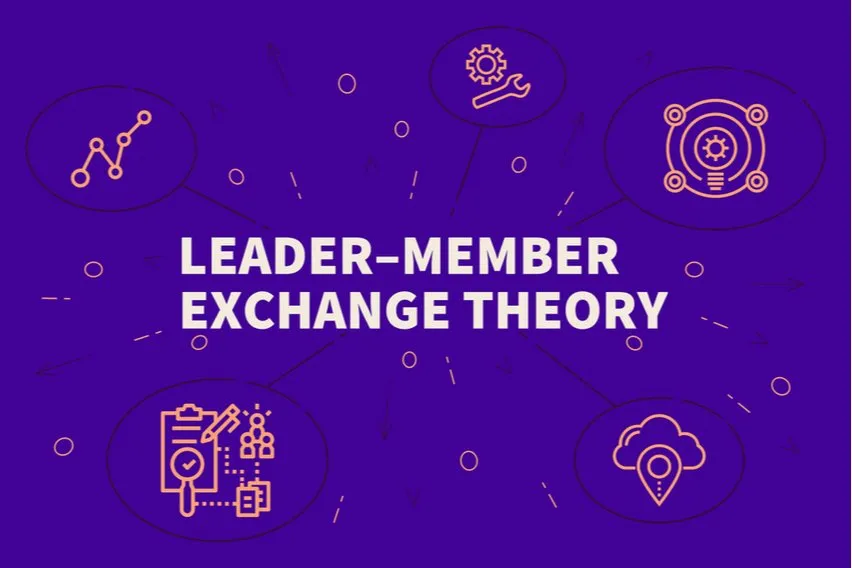Leader-Member Exchange Theory: An Extensive Guide

There’s something called the “Leader Member Exchange Theory”. This theory could be having a big effect on the happiness level and productivity of your employees.
So, what is “Leader-Member Exchange Theory”? The LMX theory is based on the idea that a leader will trust certain employees and reject others. This is based on their own subconscious biases and personality preferences.
You’re probably reading this thinking that you treat every employee with the same amount of attention and respect. While this might seem true for you as the team lead, the employees who work under you will organize themselves into a social hierarchy. With some people feeling appreciated and close to you and others feeling like second bananas.
The good news is…it doesn’t have to be this way. Being aware of Leader-Member Exchange Theory can help you support all members of your team and invite everyone into your circle of mutual trust.
But first, let’s take a trip down LMX theory lane. How did this social system get formed in the first place?
Here’s What We’ll Cover:
The 4 Stages of Leader-Member Exchange Theory
Consequences of Leader-Member Exchange Theory
Tips on How to Counteract Leader-Member Exchange Theory
The 4 Stages of Leader-Member Exchange Theory
Stage 1: Role-taking
In this preliminary stage, the team is formed and roles are assigned. Some of these team members are well-known to you whereas others are brand new. It doesn’t matter how long you’ve known someone on your team, it’s your personal biases that will decide who you will trust with the more important tasks.

Stage 2: Role-making
As new members take on their roles, the manager or leader will be observing to see if they are competent enough to enter their inner circle. This inner circle is also known as the “in-group”. The role-making process is when new relationship bonds are formed. Something will sort of “click” in your brain to start trusting some team members and not others.
Stage 3: Leadership-making
The leadership-making stage marks the transition from stranger to friend. Any team members you have sorted into your “in-group” will develop into trusted partners and the “out-group” will stay on the outskirts. Poor out-group!
Stage 4: Team-making
In this final stage, a “leadership network” will have formed. The levels of trust between you and your team will create a certain result in how your daily work gets carried out. This will be either positive or negative.
Consequences of Leader-Member Exchange Theory
What happens when the Leader-Member Exchange Theory gets out of hand?? Is it that big of a deal? According to Graen & Uhl-Bien, the founders of this social exchange theory, disregard of the LMX Theory can result in negative employee outcomes. These can include a higher turnover rate, lack of job commitment, low employee job satisfaction and conflict amongst staff. Members in the “in-group” will be given more opportunities and higher pay. The “out-group” might feel taken advantage of and miss out on opportunities to contribute their skills.
Here are some action steps you can take to make sure that the social dynamic between you and your team stays in balance:
Tips on How to Counteract Leader-Member Exchange Theory
1. Devote more time to socialization
Graen & Uhl-Bien discovered that more opportunities to connect reduced the chance of being categorized into in and out-groups. Planning a social gathering would be a great way to level the playing field and give everyone an opportunity to make a good impression on you. Some people need the invitation to connect whereas others are quite comfortable striking up a conversation. Make the social gathering mandatory and have it take place during work hours. This way, you can know for sure that everyone will be present.
2. Recognize your biases
Look back to one of your high school classes and think of all the different types of people who sat at the desks around you. There were some shy people…some athletic people…artistic people…loud people. You didn’t get along with all of them, but there were 2 or 3 whom you liked and could even picture yourself being friends with. This unconscious bias is alive and well, even as an adult. This is why it’s important to recognize the type of people you prefer being around. Maybe you prefer deep thinkers or people who talk a lot or maybe you just can’t relate to people who are obsessed with sports. Recognize these preferences you have and challenge them. It might be true that you never got along with people who wore black, but is this something that you should really be taking seriously as a team leader?
3. Require leader-to-member interaction
Certain studies have shown that team members who report to their managers tend to see the relationship as positive. Whereas members who worked independently saw the relationship with their managers as negative. A really simple way to increase engagement with your team members is to require them to report to you at certain intervals. Sitting down one-on-one will make your employees feel like they have a closer connection to you and will feel more motivated to do good work.

4. Get involved in the workspace
Take a page from Michael Scott’s book and check-in with your team members while they work. This is especially helpful if you’ve become used to only talking to a few of your favorite “in-group” people. It will show the members who have fallen to the sides that you are always open to connecting and collaborating with them. The effort definitely won’t go unnoticed!
5. Give the out-group opportunities to prove themselves
It’s important as a team leader to keep giving your out-group opportunities to grow and become better employees. The in-group jived with you right away. They fit in well to your personality preferences and are confident enough to take initiative and understand what you need from the get-go. Other employees may be just as talented but don’t come from the same world as you either personality-wise or creatively. Give these out-group employees multiple chances to prove themselves to you before you edge them out of your inner circle.
Key Takeaways
The Leader-Member Exchange Theory or “Vertical Dyad Linkage Theory” is nothing to be afraid of. As long as you know what to look out for, it’s totally in your control to make sure that your workplace doesn’t become an example of it.
Keep in mind the stages in which the theory can materialize:
- Stage 1: Role-taking
- Stage 2: Role-making
- Stage 3: Leadership-making
- Stage 4: Team-making
Counteract the theory by giving your team members more opportunities to connect with you and fight personal biases. Give your out-group a second chance to prove themselves and make an effort to talk to all of your team members, not just your in-group. These small interactions will help to harmonize your workplace in no time.
Find out more about social exchange theories on our resource hub.
RELATED ARTICLES

 Top 5 Memorization Techniques For Professionals
Top 5 Memorization Techniques For Professionals 15 Time Management Techniques
15 Time Management Techniques How to Make a Gantt Chart in Excel: A Step By Step Guide
How to Make a Gantt Chart in Excel: A Step By Step Guide What Is Order Management? A Complete Guide
What Is Order Management? A Complete Guide How to Write a Business Plan Cover Page: 5 Essential Tips
How to Write a Business Plan Cover Page: 5 Essential Tips